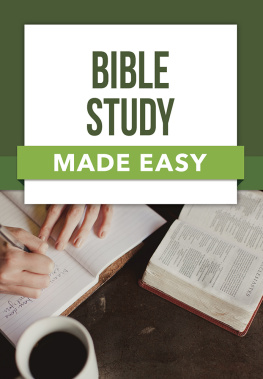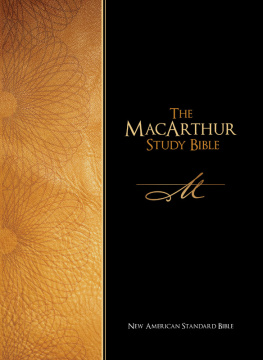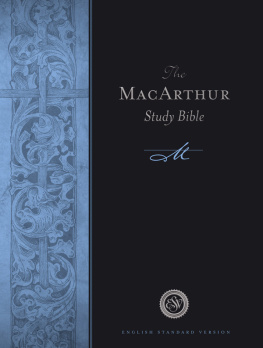The Bible Study Handbook
A Comprehensive Guide to an Essential Practice
Lindsay Olesberg
Foreword by Ajith Fernando

www.ivpress.com/connect
InterVarsity Press
P.O. Box 1400
Downers Grove, IL 60515-1426
World Wide Web: www.ivpress.com
E-mail:
2012 by Lindsay Olesberg
All rights reserved. No part of this book may be reproduced in any form without written permission from InterVarsity Press.
InterVarsity Press is the book-publishing division of InterVarsity Christian Fellowship/USA, a movement of students and faculty active on campus at hundreds of universities, colleges and schools of nursing in the United States of America, and a member movement of the International Fellowship of Evangelical Students. For information about local and regional activities, write Public Relations Dept. InterVarsity Christian Fellowship/USA, 6400 Schroeder Rd., P.O. Box 7895, Madison, WI 53707-7895, or visit the IVCF website at www.intervarsity.org.
Scripture quotations, unless otherwise noted, are from the New Revised Standard Version of the Bible, copyright 1989 by the Division of Christian Education of the National Council of the Churches of Christ in the USA. Used by permission. All rights reserved.
While all stories in this book are true, some names and identifying information in this book have been changed to protect the privacy of the individuals involved.
Cover design: Cindy Kiple
Interior design: Beth Hagenberg
Images: Badge icons: shopping: Cagri Oner/iStockphoto Badge icons: education: Cagri Oner/iStockphoto
ISBN 978-0-8308-6344-0 (digital)
ISBN 978-0-8308-1049-9 (print)
Contents
To my beloved Jon, who supported me every step of the way.
And to our dear children, Michael and Marymay you come to enjoy the riches of Gods Word as your parents do.
About the Author
Lindsay Olesberg is the Scripture manager for the Urbana Student Missions Convention. She has overseen the Bible study and exegesis at major evangelical gatherings throughout the world.
Acknowledgments
C hristian leaders dont develop in isolation; they are nurtured in community and developed by mentors. I am no exception. Im deeply grateful to the InterVarsity staff team in Los Angeles in the late 1980s/early 1990s for making manuscript Bible study the center of our life and ministry. Our years together were some of the richest in my life as we built a common understanding of the Gospel of Mark and sought to embody that understanding on campus. Many of the ideas in this book were developed by that team. Ive merely sought to gather and articulate our insights about inductive study for a broader audience.
God has blessed me with remarkable mentors who have been loving friends as well as skilled coaches. Lisa Adamovich Engdahls passion for the Scripture and commitment to make space for the Word was infectious. She was the first to affirm my teaching gifts and gave me many opportunities to learn and grow. Lisa, more than any other leader, has shaped my understanding of the spirituality of study and teaching. Al Anderson walked with me through darker days and provided affirmation of Gods call on my life as a teacher and leader. Bob Grahmann made space for me in the broader ministry of InterVarsity by inviting me to teach and train alongside him. He has been my closest partner in thinking through adjustments and new possibilities for manuscript study in a postmodern world. In this book, he will find echoes of our many conversations and experiments.
I am thankful for the staff at InterVarsity Press who share my love for the Scripture and have been so encouraging about this project. Particular thanks goes to Andy Le Peau for initiating the interaction which led to this book and to my editor, Dave Zimmerman, whose feedback and perspective has been invaluable.
Finally, I am grateful for my family and all their love and support. My father provided a model of rigorous thinking and of discipline as a writer in addition to his love and affirmation. My mother has been a true servant, helping me to juggle my many responsibilities and filling in the gaps as needed. My stepmothers life of courageous leadership as a woman in a field previously dominated by men has been a constant source of inspiration as Ive developed as a female leader and teacher in the evangelical world. My husband has been my best friend and greatest fan. His insightful questions and constructive input have helped me at every stage of writing.
Appendix A:

Tips for Small Group Leaders
S tudying the Bible together inductively is a lot of fun, but it can get pretty chaotic without someone leading the small group. The role of a Bible study leader is a lot like a traffic cop on a busy street: signaling when to go and when to stop, deciding whose turn it is in the intersection, helping pedestrians cross the street safely. Like a traffic cop, a small group leader pays attention to the entire situation rather than an individual car or a personal destination. Their role includes
- explaining the inductive method (the first handout in appendix B can be used to introduce inductive study; the second handout is a tool to help a group learn how to pay closer attention to the text)
- helping the group abide by the ground rules (see chapter twenty-one)
- deciding which questions and in which order to discuss as a group
- encouraging the group to keep looking to the text
- pacing the group discussion so that there is adequate time for application
- summarizing the core message
- selecting application questions
The annotated outline of a one-hour manuscript study explains how specifically to guide a group through the inductive process. If the group has more than an hour to study together, each category can be expanded proportionally. For tips about how much biblical text to cover in a session, read more about selection in chapter twelve.
Annotated outline of a one-hour Inductive Bible Study
- Introduction2 minutes (a little longer the first day)
Share cultural background and context information.
Read the passage out loud.
- Individual time5 minutes
Give group members time to study the passage individually.
Encourage them to
- look for the specifics such as who, what, when, where and how
- look for connections within the text such as repetitions and contrasts
- enter the text experientially by becoming one of the characters in the story
- write down the questions that come to their mind
- Share observations/questions together15 minutes
Ask: What do you see here, and what questions do you have? To encourage the sharing ask open-ended questions such as What else did you see? and What else did you notice? Do not ask content questions such as Where were Jesus and the disciples going? or Who did Jesus encounter on the road to Samaria? These kind of questions shut down the sharing process because they are not open-ended.
Note the questions group members raise, but remind the group that you wont be discussing them till later.








![Thomas Nelson - The NKJV Study Bible [Full-Color Edition]](/uploads/posts/book/79115/thumbs/thomas-nelson-the-nkjv-study-bible-full-color.jpg)



